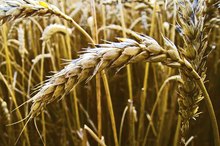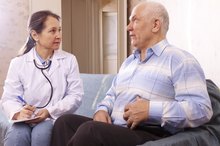Causes of Intermittent Diarrhea & Gas
The distressing symptoms of intermittent diarrhea and gas can occur due to a variety of problems within the intestine. These symptoms may be functional in nature, without any underlying disease, or they may indicate a pathological process. Sometimes they are the direct result of an intolerance to a particular food. Depending on the cause, some cases of intermittent gas and diarrhea will resolve on their own while others may require medication, or dietary restrictions.
Lactose Intolerance
Lactose is a sugar found in milk, and products made from milk. Some people are deficient in the intestinal enzyme lactase, needed for the breakdown of lactose. This deficiency can lead to bouts of gas and diarrhea. Symptoms of lactase deficiency develop over time, and usually don't appear until adolescence or later. The cause may have a genetic component, or it can arise after injury to the small intestine from severe intestinal disease, or chemotherapy drugs. The amount and type of milk product that produces symptoms varies greatly from person to person. Symptoms develop after consuming dairy, and may include gas, diarrhea, abdominal pain and nausea.
Restriction or avoidance of dairy products relieves symptoms. Lactase supplements are also available, and can help lessen the effects of lactose intolerance.
- Lactose is a sugar found in milk, and products made from milk.
- The cause may have a genetic component, or it can arise after injury to the small intestine from severe intestinal disease, or chemotherapy drugs.
Irritable Bowel Syndrome
Mayo Clinic IBS Diet
Learn More
Irritable bowel syndrome, also known as IBS, is another condition that often produces episodes of gas and diarrhea. Sufferer's also tend to have abdominal pain or discomfort, and many experience constipation as well. IBS is fairly common, affecting abut 20 percent of U.S. adults, says the NDDIC. Psychological stress, genetic and dietary factors all play a role in the condition.
Although symptoms are variable, people with IBS generally have discomfort in the lower abdomen which is relieved by a bowel movement. Many experience alternating diarrhea and constipation. Loose stools are a common complaint, as are gas and bloating. Treatments include emotional support, fiber supplements, anti-diarrheals, and avoidance of foods that trigger symptoms. A doctor may also prescribe anti-depressant medications.
- Irritable bowel syndrome, also known as IBS, is another condition that often produces episodes of gas and diarrhea.
- Sufferer's also tend to have abdominal pain or discomfort, and many experience constipation as well.
Celiac Disease
Celiac disease, also known as gluten sensitive enteropathy, is caused by an autoimmune reaction to gluten, a component of wheat, barley and rye.cause:
- Celiac disease
- also known as gluten sensitive enteropathy
- is caused by an autoimmune reaction to gluten
- a component of wheat
- barley
- rye
This condition damages the tiny villi of the small intestine, eventually resulting in poor nutrient absorption. Symptoms of celiac disease vary widely, and present differently in adults than in children. One of the primary symptoms in adults is intermittent diarrhea. Avoidance of foods containing gluten relieves symptoms.
- Celiac disease, also known as gluten sensitive enteropathy, is caused by an autoimmune reaction to gluten, a component of wheat, barley and rye.cause: * Celiac disease
* also known as gluten sensitive enteropathy
* is caused by an autoimmune reaction to gluten
* a component of wheat
* barley
* rye This condition damages the tiny villi of the small intestine, eventually resulting in poor nutrient absorption. - One of the primary symptoms in adults is intermittent diarrhea.
Related Articles
References
- The American College of Gastroenterology: What is Celiac Disease (CD)?
- Nemeth V, Zulfiqar H, Pfleghaar N. Diarrhea. [Updated 2019 Jun 8]. In: StatPearls [Internet]. Treasure Island (FL): StatPearls Publishing; 2019 Jan-. Available from: https://www.ncbi.nlm.nih.gov/books/NBK448082/
- Azzouz LL, Sharma S. Physiology, Large Intestine. [Updated 2019 Apr 16]. In: StatPearls [Internet]. Treasure Island (FL): StatPearls Publishing; 2019 Jan-. Available from: https://www.ncbi.nlm.nih.gov/books/NBK507857/
- Schiller LR, Pardi DS, Sellin JH. Chronic Diarrhea: Diagnosis and Management. Clin Gastroenterol Hepatol. 2017;15(2):182-193.e3.
- Islam MS, Sakaguchi E. Sorbitol-based osmotic diarrhea: possible causes and mechanism of prevention investigated in rats. World J Gastroenterol. 2006;12(47):7635–7641. doi:10.3748/wjg.v12.i47.7635
- Thiagarajah JR, Donowitz M, Verkman AS. Secretory diarrhoea: mechanisms and emerging therapies. Nat Rev Gastroenterol Hepatol. 2015;12(8):446–457. doi:10.1038/nrgastro.2015.111
- Sarna SK. Colonic Motility: From Bench Side to Bedside. San Rafael (CA): Morgan & Claypool Life Sciences; 2010. Colonic Motility Dysfunction. Available from: https://www.ncbi.nlm.nih.gov/books/NBK53473/
- Binder HJ. Causes of chronic diarrhea. N Engl J Med. 2006;355(3):236-9.
- Wenzl HH. Diarrhea in chronic inflammatory bowel diseases. Gastroenterol Clin North Am. 2012;41(3):651-75.
- Zopf Y, Baenkler HW, Silbermann A, Hahn EG, Raithel M. The differential diagnosis of food intolerance. Dtsch Arztebl Int. 2009;106(21):359–370. doi:10.3238/arztebl.2009.0359
- InformedHealth.org [Internet]. Cologne, Germany: Institute for Quality and Efficiency in Health Care (IQWiG); 2006-. Infectious diarrhea: Overview. 2016 Jun 30. Available from: https://www.ncbi.nlm.nih.gov/books/NBK373090/
- Del Giudice ME, Vella ET, Hey A, Simunovic M, Harris W, Levitt C. Systematic review of clinical features of suspected colorectal cancer in primary care. Can Fam Physician. 2014;60(8):e405–e415.
- Mohammadi R, Hosseini-Safa A, Ehsani Ardakani MJ, Rostami-Nejad M. The relationship between intestinal parasites and some immune-mediated intestinal conditions. Gastroenterol Hepatol Bed Bench. 2015;8(2):123–131.
- Azer SA, Sankararaman S. Steatorrhea. [Updated 2019 Jun 4]. In: StatPearls [Internet]. Treasure Island (FL): StatPearls Publishing; 2019 Jan-. Available from: https://www.ncbi.nlm.nih.gov/books/NBK541055/
- Deng Y, Misselwitz B, Dai N, Fox M. Lactose Intolerance in Adults: Biological Mechanism and Dietary Management. Nutrients. 2015;7(9):8020–8035. Published 2015 Sep 18. doi:10.3390/nu7095380
- Rubio-Tapia A, Barton SH, Murray JA. Celiac disease and persistent symptoms. Clin Gastroenterol Hepatol. 2011;9(1):13–e8. doi:10.1016/j.cgh.2010.07.014
- von Volkmann HL, Brønstad I, Gilja OH, et al. Prolonged intestinal transit and diarrhea in patients with an activating GUCY2C mutation. PLoS One. 2017;12(9):e0185496. Published 2017 Sep 28. doi:10.1371/journal.pone.0185496
- Maser C, Toset A, Roman S. Gastrointestinal manifestations of endocrine disease. World J Gastroenterol. 2006;12(20):3174–3179. doi:10.3748/wjg.v12.i20.3174
- Ogbonnaya KI, Arem R. Diabetic diarrhea. Pathophysiology, diagnosis, and management. Arch Intern Med. 1990;150(2):262-7.
- Chassany O, Michaux A, Bergmann JF. Drug-induced diarrhoea. Drug Saf. 2000;22(1):53-72.
- National Research Council (US) Subcommittee on Nutrition and Diarrheal Diseases Control. Nutritional Management of Acute Diarrhea in Infants and Children. Washington (DC): National Academies Press (US); 1985. 1, NUTRITIONAL CONSEQUENCES OF ACUTE DIARRHEA. Available from: https://www.ncbi.nlm.nih.gov/books/NBK219100/
- Descoteaux-Friday GJ, Shrimanker I. Chronic Diarrhea. [Updated 2019 Jul 5]. In: StatPearls [Internet]. Treasure Island (FL): StatPearls Publishing; 2019 Jan-. Available from: https://www.ncbi.nlm.nih.gov/books/NBK544337/
- Manual for the Health Care of Children in Humanitarian Emergencies. Geneva: World Health Organization; 2008. 3, Diarrhoea and dehydration. Available from: https://www.ncbi.nlm.nih.gov/books/NBK143745/
- Srinivasan R, Friedel DM. Colonoscopy versus flexible sigmoidoscopy in evaluation of chronic diarrhea. Gastrointest Endosc. 2000;52(4):589-90.
- Rahman MM, Ghoshal UC, Sultana S et al. Long-Term Gastrointestinal Consequences are Frequent Following Sporadic Acute Infectious Diarrhea in a Tropical Country: A Prospective Cohort Study. Am J Gastroenterol. 2018 Aug 31. doi: 10.1038/s41395-018-0208-3. [Epub ahead of print]
- Wilson DP, Patni N. Should children with chronic diarrhea be referred to a lipid clinic? J Clin Lipidol. 2018 Jun 25. pii: S1933-2874(18)30262-9. doi: 10.1016/j.jacl.2018.06.004. [Epub ahead of print]
- Itan Y, Jones BL, Ingram CJ, Swallow DM, Thomas MG. A worldwide correlation of lactase persistence phenotype and genotypes. BMC Evol Biol. 2010 Feb 9;10:36. doi:10.1186/1471-2148-10-36
- Voisin MR, Borici-Mazi R. Anaphylaxis to supplemental oral lactase enzyme. Allergy Asthma Clin Immunol. 2016;12:66. doi:10.1186/s13223-016-0171-8
- Forsgård RA. Lactose digestion in humans: intestinal lactase appears to be constitutive whereas the colonic microbiome is adaptable. Am J Clin Nutr. 2019 Aug 1;110(2):273-9. doi:10.1093/ajcn/nqz104
- Hodges JK, Cao S, Cladis DP, Weaver CM. Lactose Intolerance and Bone Health: The Challenge of Ensuring Adequate Calcium Intake. Nutrients. 2019 Mar 28;11(4). pii: E718. doi:10.3390/nu11040718.
- Ibba I, Gilli Z, Boi MF, Usai P. Effects of Exogenous Lactase Administration on Hydrogen Breath Excretion and Intestinal Symptoms in Patients Presenting Lactose Malabsorption and Intolerance. BioMed Res Int. 2014;2014:680196 (7 pages). doi:10.1155/2014/680196
- Ojetti V, Gigante G, Gabrielli M, et al. The effect of oral supplementation with Lactobacillus reuteri or tilactase in lactose-intolerant patients: randomized trial. Eur Rev Med Pharmacol Sci. 2010;14(3):163-70.
Writer Bio
Kalli Harrison is a naturopathic physician living in Portland, Ore. She graduated from National College of Naturopathic Medicine in the year 2000, and also holds a degree as a medical laboratory technician. Dr. Harrison has been writing health and medical information for patients and clients for more than 10 years.








